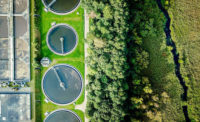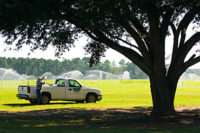Companies make the news, rightfully, when they make mistakes with food recalls or polluting.
Just this winter, Tyson Foods’ poultry subsidiary paid a $2 million fine for discharges that caused fish to die in a nearby Missouri stream. Before that, in November 2017, Pilgrim’s Pride settled a lawsuit for $1.4 million, which claimed its processing plant was polluting the Suwannee River in Florida.
Unseen, however, are the many hours officials spend creating, implementing and following a comprehensive plan to prevent contamination. Case in point: Wastewater treatment systems for the meat and poultry industry are using creative, high-tech options to clean up biohazards in their wastewater.
Meat or poultry processing plants’ wastewater is challenging to clean up because of the nutrients in its water, says Joseph Cotruvo, president, Joseph Cotruvo and Associates, based in Washington, D.C., who has more than 42 years of experience in water treatment technology.
“A lot of fat is floating on the surface, nutrients like nitrogen and phosphates and dissolved organics are in the water,” he explains. “Any food product, really, produces nasty stuff to be cleaned up.”
Plants generally partially treat the water, remove fats, put the waste in a lagoon for further treatment through a combination of physical, biological and chemical processes for a predetermined amount of time then discharge it to a river or stream, Cotruvo says.
“If facilities have land, that helps with the cleanup process,” he says, because the diluted material can be used as a water-based fertilizer instead of discharging it to a river. “Otherwise, if land is restricted, the plant has to do more processing. Any waste can be treated mechanically with filtration, but it’s expensive.”
Where companies run into trouble is if their discharged wastewater has increased nitrogen levels, because that can cause algae to grow and decrease the oxygen in the water, which asphyxiates fish, Cotruvo says.
Here’s how two poultry processors are improving their wastewater treatment systems, as told to Paul Bredwell, vice president – environmental programs, U.S. Poultry & Egg Association, based in Tucker, Ga.
Designing dependable systems
Common-sense strategies — with the help of monitoring and reporting equipment — are key. “Strategies vary from facility to facility, according to variables such as availability and cost of each,” says the poultry processor. “If we generalize across the board, you would find that we generally use the following techniques and strategies for cost reduction:
- Minimizing chemical cost through contract agreements, leveraging companywide demand for certain chemicals.
- Minimizing contract operations and services by sourcing from within.
- Designing systems that are dependable and have low operational cost (such as anaerobic digestion where possible).
- Reuse water where possible.”
This company reuses water through its systems design (low-volume nozzles, auto-shutoff valves, strategically placed application points and use of dip tanks), close usage monitoring, setting goals and well-informed associates.
“The biggest advancement in the treatment of wastewater in recent years, in my opinion, is the advancement in monitoring and reporting equipment,” the source says. “Now we can monitor control points better than ever and respond quicker than ever. In some cases, staffing can be reduced or redirected because of our ability to monitor, alarm and respond to process changes almost instantaneously, even when we are away.”
The food industry feels the pressure to keep up with newly developed regulations — and their costs. “Oftentimes it seems the burden to respond and remediate an environmental issue is unfairly cast to the poultry and other proteins industry,” the source says. “For example, unreasonable phosphorus limits are being imposed across the nation, oftentimes arbitrarily or without considering impact vs. cost calculations. More and more ‘location’ is becoming a critical part of the equation to be successful.”
Optimizing performance
This poultry processor takes monitoring control software to the next level. Its facility uses an interactive, Web-based process control and data management system to perform operation and management (O&M) services and to manage and track regularly scheduled activities at specific sites, says the source.
“To use the Web-based process control and data management system, secure access must be provided to selected members of the O&M team and our company’s environmental managers,” says the source. “Once access is provided, wastewater operators and field technicians utilize ruggedized protected tablets to enter the daily operational data directly into the database when field entries are required.”
Field-collected data on tablet devices can be instantly matched with centralized and established uniform database structure to provide data integrity right from the field.
“Because of the need for tools in mathematical problem solving, the Web-based process control and data management system program provides a variety of both simple and complex mathematical calculations automatically” for report generation, Discharge Monitoring Reporting (DMRs) submission and compliance reporting, the source says.
The software and programs have triple-redundancy where uploaded data is stored on three separate servers at three separate locations every time the data is sent to the servers.
“Our entire team is dedicated to reducing their water and environmental footprint,” the source says. “They do this through careful management of energy usage, chemical dosage and waste by-products.”
The treatment of poultry further processing wastewater generates a high volume of residuals from the influent screens, the Dissolved Air Floatation (DAF) and activated sludge processes.
“This residual product, known as either screenings or waste sludge, is highly valuable,” says the source. “Screenings are sent off to local rendering where their proteins are extracted for reuse. Sludge waste is loaded with concentrated nutrients and when applied properly serves as an excellent soil amendment that enhances the growth of feed crops.”
All treatment waste sludge residuals are re-used instead of being sent to landfills. “Since plant startup in August 2009, a contracted agent has land applied over 4 million gallons of our nutrient-rich sludge to pastures and cropland cultivated with soybeans, corn, rye, Bermuda and fescue grasses [and more than 3 million pounds of waste meat has been screened and recycled],” says the source.
During the design phase of the plant, the poultry company and professional contract operations firm anticipated future challenges with wastewater, such as increased production challenging the biological processes, shifting effluent limits, using clean-in-place chemicals and the ever-fluctuating price for treatment chemicals.
“The selection of the Modified Ludzak-Ettinger (MLE) biological treatment process allows us to reduce blower energy up to 25 percent, provide the robust performance we require to meet stringent effluent limits by optimizing BOD [biochemical oxygen demand] and nitrogen removal, maximizing oxygen transfer efficiency and the ability to recover quickly from the occasional upset,” says the source.
A cost-efficient and compliant treatment strategy was created by optimizing performance through the use of technology, the continued search for options for creative reuse of waste solids and taking advantage of reducing energy consumption no matter how small the incremental reductions are, says the source.
“Science, technology, politics, environment, quality and cost are all wrapped up in wastewater treatment systems,” says Cotruvo. “The technology is there to clean it. We can take any water and treat it purer than drinking water, but it costs.” NP






Report Abusive Comment